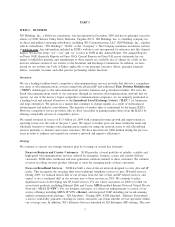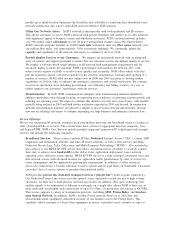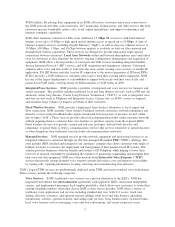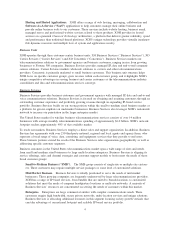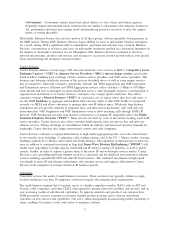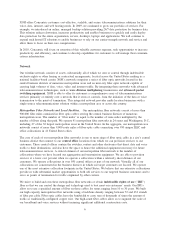XO Communications 2009 Annual Report Download - page 14
Download and view the complete annual report
Please find page 14 of the 2009 XO Communications annual report below. You can navigate through the pages in the report by either clicking on the pages listed below, or by using the keyword search tool below to find specific information within the annual report.fiber-based network providers have initiated operations by buying up and integrating smaller local and regional
fiber networks.
As a result of increasing competitive forces, including technological advances, service providers have reduced
the prices charged for telecommunication services in recent years. We expect to continue experiencing
downward price pressure with respect to our service offerings. Our ability to reduce prices in response to
competitive pressures may be limited by our reliance on some of our principal competitors to provide key
network elements that we need to provide network services, our ability to successfully deploy technologies
that improve our network operating efficiencies, and our ability to continue to drive other cost structure
improvements.
Regulatory environments at both the state and federal levels have considerable influence on our industry. We
continually monitor regulatory developments and remain active in our participation in regulatory issues. See
“Description of Business — Regulatory” and “Risk Factors” for further discussion of the regulatory environ-
ment and its impact on us.
Several new technologies are being adopted by telecommunications carriers that could cause significant
changes and opportunities in the competitive landscape for telecommunications services. Such technologies
include (but are not limited to):
• IP Communications — IP technology enables delivery of voice and data telecommunications services
over a single IP network which is less costly to operate than the existing PSTN.
• Mobile Wireless Technologies — New high bandwidth applications, commonly referred to as 3G
broadband wireless networks, allow the delivery of voice and data (including video) via wireless
connection. We believe 3G wireless networks together with the development of next generation, or 4G,
wireless networks, will accelerate the adoption of wireless data services by both consumers and
enterprises.
We are continuing to experience revenue growth from customers using our IP-based network infrastructure.
This revenue growth is partially offset by the continued and expected decline in our traditional legacy services.
We have deployed our own suite of IP data and VoIP solutions and anticipate adding new services with more
IP-enabled features to target larger customers. Within IP, we are seeing ethernet becoming the accepted
standard for high-speed connections. The continued rapid growth of the internet, including the acceptance of
video being delivered over the internet, has led to various customers requiring faster connections.
We believe the continued market growth for mobile wireless telecommunications services, including the rapid
adoption of data and internet enabled mobile devices, and increased demand for high-speed broadband services
will require wireless telecommunications carriers and our business customers to need significantly greater
bandwidth. Upgrades to our IP-based network infrastructure in recent years and anticipated continued
enhancements will position us well to meet this demand.
Regulatory
Overview. We offer wireline and fixed wireless communications services to small and medium sized
businesses, large enterprises, government agencies, and wireline and wireless telecommunications providers.
We are therefore subject to regulation by federal, state and local government agencies.
With a few limited exceptions, the FCC has exclusive jurisdiction over our provision of interstate and
international telecommunications services, and the state regulatory commissions regulate our provision of
intrastate telecommunications services. Additionally, municipalities and other local government agencies may
regulate limited aspects of our business, such as use of government-owned rights-of-way, and may require
permits such as zoning approvals and building permits.
10



